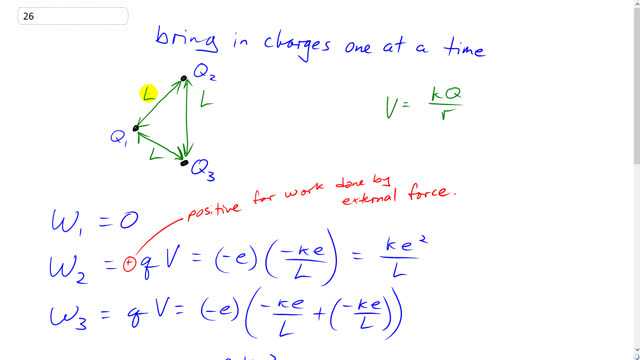
How much work must be done to bring three electrons from a great distance apart to from one another (at the corners of an equilateral triangle)?

In order to watch this solution you need to have a subscription.
This is Giancoli Answers with Mr. Dychko. Whether an external force brings in these three charges at the same time or instead brings them in one at a time one after the other makes no difference to the total amount of work done. So, but it does make a difference to our calculation and it is much easier to think about doing one at a time. So we'll bring in charge one into this empty space when no other charges are there yet. In which case it takes no work to do because there's no other charges around to create any potential difference compared to infinity. So basically take no work to put it there and then bringing charge Q two into its position here at distance L from charge Q one will take some work because it'll be equal to the charge times the potential, the potential difference between its destination and where it started. So the charges… and I have a positive here by the way because this is for work done by an external force. The work done by the electric field created by Q one is negative q V. But this is work done by an external force and it's going in the... and it's going to be positive q V. So we have a charge of negative e for Q two and that's going to be multiplied by the potential due to Q one, negative k e over L, potential for point charge is k times coulombs constant times the charge Q divided by the distance from the charge and we're a distance capital L from Q one and the charge on Q one is negative e and this makes positive k e squared over L so take some positive work to bring this electron Q two here and we expect that because these forces are… or these these charges are repelling each other. And so the external force is going to have to be directed towards Q one. This is the external force on Q two as it brought it from infinity to here. And it's gonna have to be in that direction because the electrostatic force is gonna be going away since it's repelling and the external force is pointing in the same direction as the displacement. We expect a positive answer for the amount of work done by that external force then bring in Q three into this position here. Now there are already two charges here. And so when Q three goes into this position it'll be the potential of this location here will be that due to Q one and plus that due to Q two. So it's negative k e over capital L plus negative k e over capital L, all multiplied by Q. Which is negative e and that makes two k e over L times e, makes two k e squared over L and becomes positive because negative times a negative is positive. And then the total work is the sum of those three. So zero plus k e squared over L plus two k e squared over L makes three k e squared over L and substituting numbers here, we have three times coulombs constant, 8.988 times ten to the nine newton meters squared per coulomb squared times the elementary charge of 1.6 times ten to the minus 19 coulombs and square that divided by the separation between the charges at 1.0 times ten to the minus ten meters and that gives 6.9 times ten to the minus 18 joules of total work done.